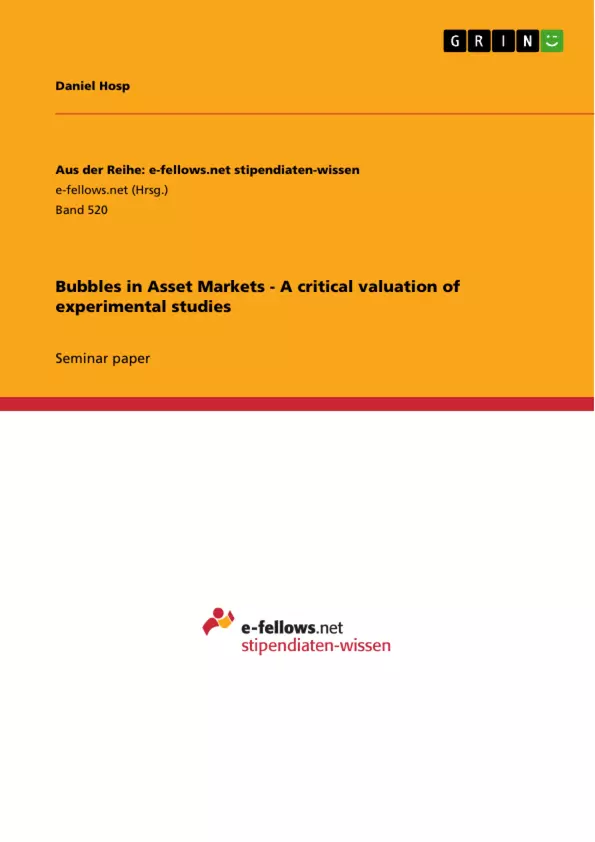Bubbles in Asset Market gibt eine kurzen Überblick darüber, wie "Blasen" in Finanzmärkten entstehen könnne und wie deren Entstehung anhand von Experimenten bisher getestet wurde. Darauf aufbauen gibt es empfehlungen für eine geändertes Design der Experimente um bessre Ergebnisse erzielen zu können.
Inhaltsverzeichnis (Table of Contents)
- Introduction
- A Definition of bubbles
- Why do bubbles emerge?
- Experience of Traders
- Riding the Bubble
- Short Selling Restrictions
- Agency Problems
- Are experiments suitable for testing the development of bubbles?
- Knowledge of the Fundamental Value
- Payout Structure
- An Alternative to Experiments
- A New Design for Experiments
- Definition of the Fundamental Value
- Identifying the Purpose of Trading
- Short Selling restrictions
- Payout structure
- Conclusion
Zielsetzung und Themenschwerpunkte (Objectives and Key Themes)
This seminar paper investigates the shortcomings of past experiments on asset bubbles, proposing an alternative design for more representative findings. It provides an overview of explanations for bubble formation, evaluating them based on accepted financial papers and experiments. The paper focuses on the impact of trader experience, riding the bubble strategy, short selling restrictions, and agency problems on bubble formation.- Critique of existing experimental studies on asset bubbles
- Proposal for an alternative experimental design
- Analysis of prominent explanations for bubble formation
- Evaluation of the role of trader experience, short selling restrictions, and agency problems
- Examination of the "riding the bubble" strategy
Zusammenfassung der Kapitel (Chapter Summaries)
- Introduction: The paper begins by defining asset bubbles as sustained price increases above the fundamental value, followed by a crash. It discusses the prevalence of bubbles throughout history and highlights the need for understanding their emergence.
- A Definition of bubbles: This chapter provides a formal definition of asset bubbles, emphasizing the concept of continuous price escalation beyond the fundamental value. It also mentions notable historical examples of bubbles, such as the Tulipmania and the South Sea Bubble.
- Why do bubbles emerge?: This chapter explores several factors that contribute to the formation of bubbles. It examines the influence of trader experience on price deviations from the fundamental value and the potential for traders to profit by "riding the bubble." It also discusses the impact of short selling restrictions on market supply and demand dynamics.
- Are experiments suitable for testing the development of bubbles?: This chapter critically analyzes the suitability of traditional experimental designs for studying asset bubbles. It discusses the limitations of providing participants with complete knowledge of the fundamental value and the potential for artificial payout structures to influence results.
- An Alternative to Experiments: This chapter briefly mentions an alternative approach to experiments, suggesting the use of real-world data and observational methods.
- A New Design for Experiments: This chapter proposes a new experimental design that addresses the shortcomings of previous studies. It outlines key elements such as defining the fundamental value, identifying the purpose of trading, and implementing realistic short selling restrictions.
Schlüsselwörter (Keywords)
This paper examines the emergence and dynamics of asset bubbles in financial markets, focusing on the shortcomings of experimental studies and proposing an alternative design. Key themes include the fundamental value of assets, trader experience, short selling restrictions, agency problems, and the "riding the bubble" strategy.
Excerpt out of 16 pages
- scroll top
- Quote paper
- Daniel Hosp (Author), 2012, Bubbles in Asset Markets - A critical valuation of experimental studies, Munich, GRIN Verlag, https://www.grin.com/document/198948
Look inside the ebook



